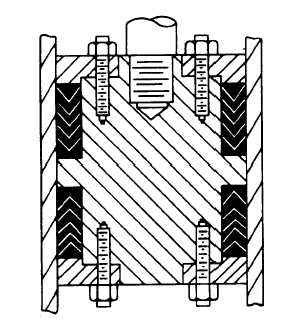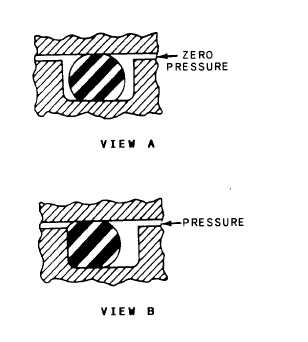packing stack, is flat on one side and V-shaped
on the other to properly support the adjacent
V-ring. Proper design and installation of the
female adapter has significant impact on the
service life and performance of the V-rings
because the female adapter bridges the clearance
gap between the moving surfaces and resists
extrusion.
The packing set is installed in a cavity that is
slightly deeper than the free stack height (the
nominal overall height of a V-ring packing set,
including the male and female adapters as
measured before installation) and as wide as the
nominal cross section of the V-rings. This cavity,
called a packing gland or stuffing box, contains
and supports the packing around the shaft, rod,
or piston. Adjustment of the packing gland depth
through the use of shims or spacers is usually
necessary to obtain the correct squeeze or
clearance on the packing stack for good service
life.
Two basic installations apply to V-ring
packings. The more common is referred to as an
outside packed installation, in which the packing
seals against a shaft or rod, as shown in figure
7-4. The inside packed installation, is shown as
a piston seal in figure 7-5. When V-ring packing
is to be used in an inside packed installation, only
endless ring packing should be used. Where
pressures exist in both directions, as on a
double-acting piston, opposing sets of packing
Figure 7-5.—Inside packed V-ring installation.
should always be installed so the sealing lips face
away from each other as in figure 7-5. This
prevents trapping pressure between the sets of
packings. The female adapters in inside packed
installations should always be located adjacent to
a fixed or rigid part of the piston.
O-RINGS
An O-ring is doughnut-shaped. O-rings are
usually molded from rubber compounds; how-
ever, they can be molded or machined from plastic
materials. The O-ring is usually fitted into a
rectangular groove (usually called a gland)
machined into the mechanism to be sealed. An
O-ring seal consists of an O-ring mounted
in the gland so that the O-ring’s cross section
is compressed (squeezed) when the gland is
assembled (fig. 7-6).
An O-ring sealing system is often one of the
first sealing systems considered when a fluid
closure is designed because of the following
advantages of such a system:
1.
2.
3.
4.
5.
6.
7.
Simplicity
Ruggedness
Low cost
Ease of installation
Ease of maintenance
No adjustment required
No critical torque in clamping
Figure 7-6.—O-ring installed in a gland.
7-6




